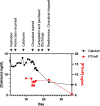Cinacalcet increases renal calcium excretion in PTHrP-mediated hypercalcemia: a case report
- PMID: 37328745
- PMCID: PMC10273565
- DOI: 10.1186/s12902-023-01386-3
Cinacalcet increases renal calcium excretion in PTHrP-mediated hypercalcemia: a case report
Abstract
Background: In the acute setting, PTH-independent hypercalcemia is typically treated with anti-resorptive agents such as zoledronic acid or denosumab. When these agents are no longer able to control hypercalcemia, several case reports have shown the utility of cinacalcet. However, it is not known if cinacalcet can be effective in patients naïve to anti-resorptive therapy or how cinacalcet ameliorates the hypercalcemia.
Case presentation: A 47-year-old male with a history of alcohol-induced cirrhosis was admitted for left cheek bleeding and swelling from an infiltrative squamous cell carcinoma of the oral cavity. On admission, he was found to have an elevated albumin-corrected serum calcium of 13.6 mg/dL, a serum phosphorus of 2.2 mg/dL and an intact PTH of 6 pg/mL (normal 18-90) with a PTHrP of 8.1 pmol/L (normal < 4.3), consistent with PTHrP-dependent hypercalcemia. Aggressive intravenous saline hydration and subcutaneous salmon calcitonin were initiated, but his serum calcium remained elevated. Given tooth extractions scheduled for the next day and possible irradiation to the jaw in the near future, alternatives to antiresorptive therapy were sought. Cinacalcet was initiated at 30 mg twice daily then increased to 60 mg twice daily the following day. The albumin-corrected serum calcium level decreased from 13.2 to 10.9 mg/dL within 48 h. The fractional excretion of calcium increased from 3.7 to 7.0%.
Conclusions: This case demonstrates the utility of cinacalcet for the treatment of PTHrP-mediated hypercalcemia without prior anti-resorptive therapy via increased renal clearance of calcium.
Keywords: Bisphosphonate; Case report; Cinacalcet; Hypercalcemia; Osteonecrosis; PTHrP.
© 2023. The Author(s).
Conflict of interest statement
The authors declare that they have no competing interests.
Figures


Similar articles
-
Cinacalcet attenuates hypercalcemia observed in mice bearing either Rice H-500 Leydig cell or C26-DCT colon tumors.Eur J Pharmacol. 2013 Jul 15;712(1-3):8-15. doi: 10.1016/j.ejphar.2013.04.013. Epub 2013 Apr 23. Eur J Pharmacol. 2013. PMID: 23623934
-
Neuroendocrine Carcinoma as a Cause of Humoral Hypercalcemia of Malignancy: A Case of a Patient With Elevated Parathyroid Hormone-Related Protein.Cureus. 2022 Mar 22;14(3):e23398. doi: 10.7759/cureus.23398. eCollection 2022 Mar. Cureus. 2022. PMID: 35481321 Free PMC article.
-
Long-Term Use of Cinacalcet in Kidney Transplant Recipients With Hypercalcemic Secondary Hyperparathyroidism: A Single-Center Prospective Study.Exp Clin Transplant. 2018 Jun;16(3):287-293. doi: 10.6002/ect.2016.0342. Epub 2017 Oct 31. Exp Clin Transplant. 2018. PMID: 29108515
-
Cinacalcet therapy in a child with novel homozygous CASR p.Glu353Lys mutation causing familial hypocalciuric hypercalcemia type 1: case report and review of the literature.Turk J Pediatr. 2023;65(5):853-861. doi: 10.24953/turkjped.2022.1040. Turk J Pediatr. 2023. PMID: 37853976 Review.
-
Effective long-term management of parathyromatosis-related refractory hypercalcemia with a combination of denosumab and cinacalcet treatment.Hormones (Athens). 2022 Mar;21(1):171-176. doi: 10.1007/s42000-021-00343-w. Epub 2022 Jan 7. Hormones (Athens). 2022. PMID: 34993886 Review.
References
Publication types
MeSH terms
Substances
Grants and funding
LinkOut - more resources
Full Text Sources
Research Materials

